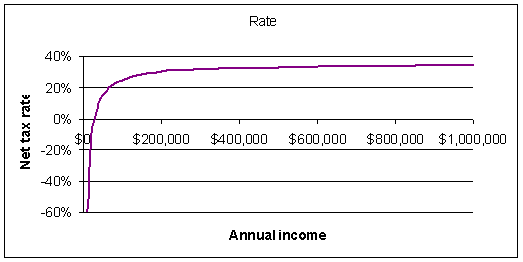How It Works: Part 2 (of 2) (see Part 1)
Taxation — the Key to Progress
Replace the current cumbersome Income Tax with a simple Flat Tax.
The current tax code and regulations total 17,601 pages (about 48 pounds). It may be purchased from the Government Printing Office for $1,215.00.1 These statistics are, to us, sufficient proof that the current taxes are too complex to be fair!
This ComingTogether Plan insists that a change in taxation methods is crucial if we are ever to achieve the merger of the ideals of Security and Opportunity. In fact, the historic procrastination on tax reform is what has locked these two fine American ideals — social compassion and individual responsibility — in an adversarial stance for years, the stance called "gridlock in government."
Under this program, both parties can cease playing games of class warfare. If we are going to have an income tax, then let's tax all income the same way, rather than treating people differently.
The tax reform proposal under this ComingTogether Plan provides progressivity in the tax paid net of benefits received, but this progressivity comes without the sharp changes in the citizenís situation due to entering a new tax bracket or becoming ineligible for a particular benefit (to understand those sharp changes, see our marginal tax rate table). Combining this tax with the Social Security tax would also remove the regressive nature that enters into the current system at the point that the Social Security maximum is achieved.
For example, consider a family for which the situation calls for basic living expense funding totaling $10,000 per year. Assume that the flat rate on income tax is 35%. (A rate that high would replace both the income tax and the Social Security taxes — both employee and employer.2) The following graph shows the tax net of benefits as a percent of income:

Click here to see more details on this data.
Income Tax Simplification
In this situation, the Net Tax Rates are similar to the rates under current law, but compliance cost would be much lower. With a fixed rate applicable to all income, withholding would be at that fixed rate. Income covered by withholding would not even need to be put on a tax return. This is much like the current Medicaid and Social Security taxes that do not show up on a tax return for the typical wage earner today.
There would be no need for the regulations promulgated to eliminate the abuse of low tax brackets, because there would be no low tax brackets. For example, there would be no tax code motivation for families to move investments to their childrenís name to get them off the parentsí tax return. Therefore, there would also be no need for tax law and regulations applying the parentsí tax rate to the childís investment income.
On the corporate side, all income would be taxed at the same rate as for individuals, and it would not be taxed again if distributed as dividends, so there would be no reason for Chapter S corporations, regulations mandating consolidation to avoid the use of multiple corporations to obtain the benefit of the lower tax brackets, and regulations attempting to define the differences between dividends and salary (excess compensation rules).
Although less significant, similar benefits would accrue from taxing income in trusts in the same manner as corporations. All taxes on taxable income within a trust would be paid by the trust, so the income distributed would not be included on the recipientís tax return.
NOTE: We understand that there will still be some complexity in determining business income. That is a complicated process to cover all situations. However, a reduction in complexity can certainly be achieved under this proposal.